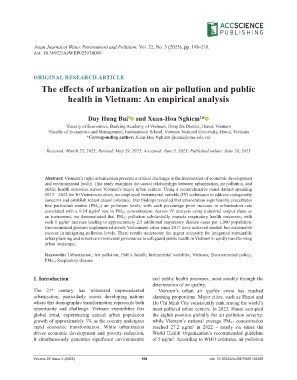Page 204 - AJWEP-v22i3
P. 204
Asian Journal of Water, Environment and Pollution. Vol. 22, No. 3 (2025), pp. 198-210.
doi: 10.36922/AJWEP025130088
ORIGINAL RESEARCH ARTICLE
The effects of urbanization on air pollution and public
health in Vietnam: An empirical analysis
Duy Hung Bui and Xuan-Hoa Nghiem *
1
2
1 Faculty of Economics, Banking Academy of Vietnam, Dong Da District, Hanoi, Vietnam
2 Faculty of Economics and Management, International School, Vietnam National University, Hanoi, Vietnam
*Corresponding author: Xuan-Hoa Nghiem (hoanx@vnu.edu.vn)
Received: March 25, 2025; Revised: May 29, 2025; Accepted: June 3, 2025; Published online: June 20, 2025
Abstract: Vietnam’s rapid urbanization presents a critical challenge at the intersection of economic development
and environmental health. This study examines the causal relationships between urbanization, air pollution, and
public health outcomes across Vietnam’s major urban centers. Using a comprehensive panel dataset spanning
2013 – 2022 for 10 Vietnamese cities, we employed instrumental variable (IV) techniques to address endogeneity
concerns and establish robust causal inference. Our findings revealed that urbanization significantly exacerbates
fine particulate matter (PM2.5) air pollution levels, with each percentage point increase in urbanization rate
associated with a 0.54 μg/m rise in PM2.5 concentration. Across IV analysis using industrial output share as
3
an instrument, we demonstrated that PM2.5 pollution substantially impacts respiratory health outcomes, with
each 1 μg/m increase leading to approximately 2.5 additional respiratory disease cases per 1,000 population.
3
Environmental policies implemented across Vietnamese cities since 2017 have achieved modest but measurable
success in mitigating pollution levels. These results underscore the urgent necessity for integrated sustainable
urban planning and robust environmental governance to safeguard public health in Vietnam’s rapidly transforming
urban landscape.
Keywords: Urbanization; Air pollution; Public health; Instrumental variables; Vietnam; Environmental policy;
PM2.5; Respiratory disease
1. Introduction and public health pressures, most notably through the
deterioration of air quality.
The 21 century has witnessed unprecedented Vietnam’s urban air quality crisis has reached
st
urbanization, particularly across developing nations alarming proportions. Major cities, such as Hanoi and
where this demographic transformation represents both Ho Chi Minh City consistently rank among the world’s
opportunity and challenge. Vietnam exemplifies this most polluted urban centers. In 2023, Hanoi occupied
global trend, experiencing annual urban population the eighth position globally for air pollution severity;
growth of approximately 3% as the country undergoes while Vietnam’s national average PM2.5 concentration
rapid economic transformation. While urbanization reached 27.2 μg/m in 2022 – nearly six times the
3
drives economic development and poverty reduction, World Health Organization’s recommended guideline
it simultaneously generates significant environmental of 5 μg/m . According to WHO estimates, air pollution
3
Volume 22 Issue 3 (2025) 198 doi: 10.36922/AJWEP025130088

